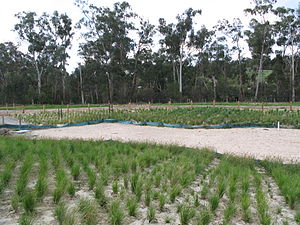
Back ترميم بيئي Arabic Ecologia de la restauració Catalan Ekologie obnovy Czech Renaturierungsökologie German Οικολογική αποκατάσταση Greek Ekologia restaŭro EO Gestión restaurativa Spanish Taastamisökoloogia ET Errestaurazio ekologiko EU بومشناسی بازسازی FA



Ecological restoration, or ecosystem restoration, is the process of assisting the recovery of an ecosystem that has been degraded, damaged, destroyed[1] or transformed.[2] It is distinct from conservation in that it attempts to retroactively repair already damaged ecosystems rather than take preventative measures.[3][4] Ecological restoration can reverse biodiversity loss, combat climate change, support the provision of ecosystem services and support local economies.[5] The United Nations has named 2021-2030 the Decade on Ecosystem Restoration.[6]
Habitat restoration involves the deliberate rehabilitation of a specific area to reestablish a functional ecosystem. This may differ from historical baselines (the ecosystem's original condition at a particular point in time).[7][8] To achieve successful habitat restoration, it is essential to understand the life cycles and interactions of species, as well as the essential elements such as food, water, nutrients, space, and shelter needed to support species populations.
Scientists estimate that the current species extinction rate, or the rate of the Holocene extinction, is 1,000 to 10,000 times higher than the normal, background rate.[9][10][11] Habitat loss is a leading cause of species extinctions[11] and ecosystem service decline.[12] Two methods have been identified to slow the rate of species extinction and ecosystem service decline: conservation of quality habitat and restoration of degraded habitat. The number and size of ecological restoration projects have increased exponentially in recent years.[13][14]
Restoration goals reflect political choices, and differ by place and culture.[15][16][17][18] On a global level, the concept of nature-positive has emerged as a societal goal to achieve full nature recovery by 2050, including through restoration of degraded ecosystems to reverse biodiversity loss.[19][20]
- ^ Society for Ecological Restoration. "Restoration Resource Center What is Ecological Restoration?". ser-rrc.org. Retrieved November 22, 2023.
- ^ Holl, Karen Davis (March 3, 2020). "Chapter 1". Primer of Ecological Restoration. United Kingdom: Island Press. ISBN 9781610919722.
- ^ "Restoration Resource Center What is Ecological Restoration?". ser-rrc.org. Retrieved February 4, 2024.
- ^ Martin, Laura (2022). Wild by Design: The Rise of Ecological Restoration. Harvard University Press. p. 5. ISBN 9780674979420.
- ^ UNEP-WCMC (April 30, 2020). "10 years to boost ecosystem restoration for people and planet". UNEP-WCMC. Retrieved July 12, 2023.
- ^ "UN Decade on Restoration". UN Decade on Restoration. Retrieved November 22, 2023.
- ^ Holl, Karen Davis (March 3, 2020). "Chapter 2". Primer of Ecological Restoration. United Kingdom: Island Press. ISBN 9781610919722.
- ^ Jones, Lizzie P.; Turvey, Samuel T.; Massimino, Dario; Papworth, Sarah K. (August 20, 2020). Chen, Xiaodong (ed.). "Investigating the implications of shifting baseline syndrome on conservation". People and Nature. 2 (4): 1131–1144. doi:10.1002/pan3.10140. ISSN 2575-8314.
- ^ Pimm, Stuart L.; Russell, Gareth J.; Gittleman, John L.; Brooks, Thomas M. (July 21, 1995). "The Future of Biodiversity". Science. 269 (5222): 347–350. Bibcode:1995Sci...269..347P. doi:10.1126/science.269.5222.347. ISSN 0036-8075. PMID 17841251. S2CID 35154695.
- ^ Simberloff, Daniel (January 1996). "Lawton, J. H. and May, R. M. (Eds.). Extinction Rates. 1995. Oxford University Press, Oxford. xii + 233 pp. Price: f17.95". Journal of Evolutionary Biology. 9 (1): 124–126. doi:10.1046/j.1420-9101.1996.t01-1-9010124.x. ISBN 0-19-854829-X. ISSN 1010-061X.
- ^ a b Sciences, National Academy of (January 1, 1988). Biodiversity. doi:10.17226/989. ISBN 978-0-309-03739-6. PMID 25032475.
- ^ Daily, Gretchen C. (1997). "Ecosystem Services: Benefits Supplied to Human Societies by Natural Ecosystems" (PDF). Issues in Ecology.
- ^ Young, T. P.; Petersen, D. A.; Clary, J. J. (April 28, 2005). "The ecology of restoration: historical links, emerging issues and unexplored realms". Ecology Letters. 8 (6): 662–673. Bibcode:2005EcolL...8..662Y. doi:10.1111/j.1461-0248.2005.00764.x. ISSN 1461-023X.
- ^ BenDor, Todd; Lester, T. William; Livengood, Avery; Davis, Adam; Yonavjak, Logan (June 17, 2015). "Estimating the Size and Impact of the Ecological Restoration Economy". PLOS ONE. 10 (6): e0128339. Bibcode:2015PLoSO..1028339B. doi:10.1371/journal.pone.0128339. ISSN 1932-6203. PMC 4470920. PMID 26083034.
- ^ Lackey, Robert (2004). "Societal values and the proper role of restoration ecologists" (PDF). Frontiers in Ecology and the Environment. 22 (4): 45–46.
- ^ Martin, Laura J. (2022). Wild by design: the rise of ecological restoration. Cambridge, Massachusetts: Harvard University Press. ISBN 978-0-674-97942-0.
- ^ Hall, Marcus (2005). Earth Repair: A Transatlantic History of Environmental Restoration. University of Virginia Press.
- ^ Higgs, Eric S.; Higgs, Eric (2003). Nature by design: people, natural process, and ecological restoration. Cambridge, Mass.: MIT Press. ISBN 978-0-262-58226-1.
- ^ Milner-Gulland, E.J.; Addison, Prue; Arlidge, William N.S.; Baker, Julia; Booth, Hollie; Brooks, Thomas; Bull, Joseph W.; Burgass, Michael J.; Ekstrom, Jon; zu Ermgassen, Sophus O.S.E.; Fleming, L. Vincent; Grub, Henry M.J.; von Hase, Amrei; Hoffmann, Michael; Hutton, Jonathan (January 22, 2021). "Four steps for the Earth: mainstreaming the post-2020 global biodiversity framework". One Earth. 4 (1): 75–87. Bibcode:2021OEart...4...75M. doi:10.1016/j.oneear.2020.12.011. ISSN 2590-3322.
- ^ "Nature Positive - A Global Goal for Nature". Nature Positive Initiative. June 21, 2024. Retrieved July 17, 2024.